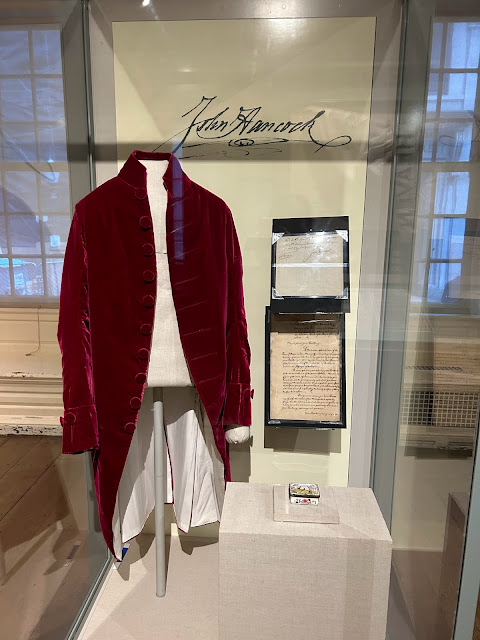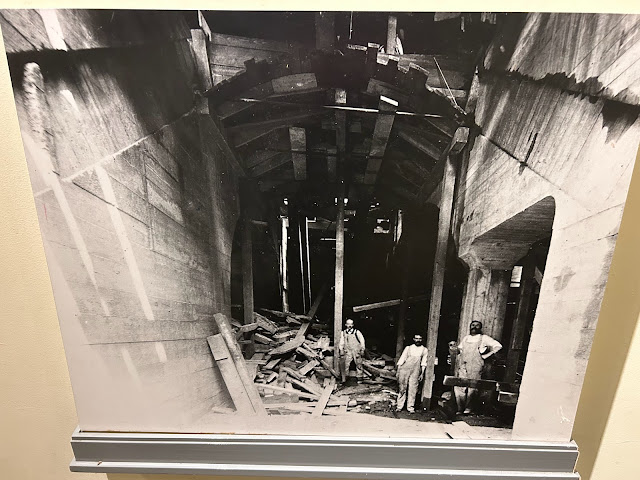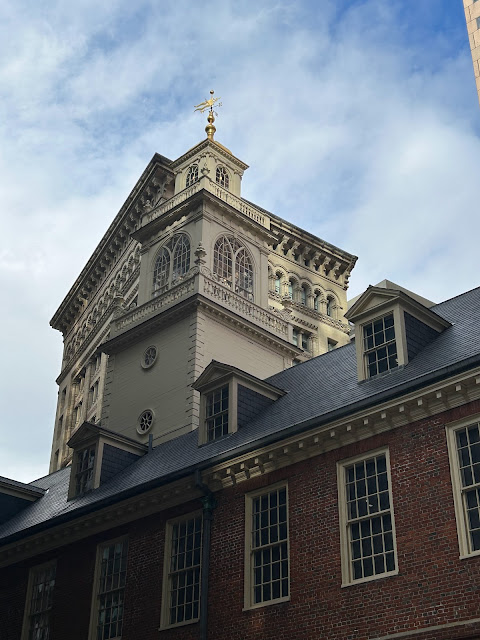Ok, so it's $35 to go into the museum where the Boston Tea Party was and that's a bit much for a 30 minute lunch walk, so you only get to see and learn about the Boston Tea Party from the outside! But if you're visiting Boston (or have more time than I did on this particular day), I definitely recommend this museum - they even have an ACTUAL tea chest from that fateful day in 1773!

The colonists that were here in Boston at the time of the Tea Party considered themselves to be British. So they weren't very happy and couldn't understand when the British government passed tax acts and levied taxes on certain products that were being imported to the colonies, such as the Townshend Revenue Act of 1767 that levied taxes on tea, glass, oil, lead, paint and paper. People naturally protested, and in 1770, they repealed this act with one exception - the TEA. Next up, the Tea Act was passed by Parliament in May of 1773 which granted a tea monopoly to the British East India Tea Company. They were particularly fired up because those same taxes weren't being imposed on British citizens over in England. Prior to the Tea Act, the colonists also had a few options on where they purchased their tea - but now, with the monopolization, there was only one place to purchase it from.
As the sign says outside, "England was imposing laws, regulations, monopolies and taxes on the people of the American colonies and denying them any say in the matters."
An official commemoration of the Boston Tea Party, by the City of Boston!
As a result, upon arrival here in Boston of the three large ships containing the tea from the British East India Company, the colonists refused to unload the tea. They wanted to send these ships back to England as they had done in Philadelphia and New York, but the colonial lieutenant governor Thomas Hutchinson refused to send them back. Instead, he tried to find a more diplomatic route for accepting the tea.

The colonists had many meetings and debates at the Old South Meeting House over the matter when finally, Samuel Adams gave the word on the evening of December 16, 1773 for the Sons of Liberty (disguised as Mohawk Native Americans) to board the three ships in this harbor and dump over 92,000 pounds of tea (still in chests) into the cold water. Take that, you stinky tea! (I kid, I love tea!) In time, this daring act, along with the consequences of the Boston Massacre led to the start of the American Revolution. England was simply trying to rule too hard, from too far.
I continued to walk across Congress Street and along the Harborwalk down to Fan Pier. This is definitely one of the most iconic views of Boston!
They have a neat little history of Fan Pier and the surrounding area here, including metal likenesses of the boats and ships that would have been floating around this harbor in the century indicated on the sculpture. After the revolution ended, there was a boom of foreign trade. Foreign commerce continued to expand through the 1800s with the Industrial Revolution and the influx of immigrants who needed the jobs that came along with that. Boston was growing!
Back Bay was filled in during the 1850s, and the South Boston and East Boston waterfront areas followed when they were filled around 1870. I like the maps in the picture above that give a good visual of this. I also thought it was interesting that the debris from the Great Fire of 1872 became the fill for Fan Pier - and that if you dig below, you would find patches of charcoal and twisted ironwork!
As America moved into the 1900s, the Seaport District continued to expand (through the dumping of fill, face palm) and Fan Pier here finally got it's name. This area actually used to be a railroad stopping point - the end of all of the train lines "fanned" out in this spot. By 1925 though, the rail lines stopped south of Seaport Boulevard and of course, as we now know, they all terminate at South Station which is on the other side of the Fort Point Channel!
Another thing you can see from Fan Pier is Logan Airport!
You also get a nice view of Jeffries Point in East Boston.
But this big sell for Fan Pier is the view of downtown Boston!
This dilapidated structure that sits (errr) in the middle of the harbor here is the old operators house for the Old Northern Avenue Bridge. It's been boarded up since 2009.
The Old Northern Avenue Bridge (which you can see on the left of the above picture) was built in 1908 to vehicular traffic, but closed to cars in 1997. It was a pedestrian only bridge up until 2014 when the city closed it down because of structural issues. This bridge was a rotating swing bridge that allowed boat traffic in and out of the area. I'm guessing they didn't want people to even attempt to cross it, so they swung it out 90 degrees to prevent people from crossing.
I also spy in this picture (on the far right side) the Custom House Tower. The tower sits on the Custom House base, which was once... you guessed it... a Custom House where they used to collect import duties and enforce maritime trade laws for Boston Harbor. The base was built in the 1830s directly on the harbor, while the tower was added on in 1915. At 496 feet tall, it was the tallest building in Boston (and all of New England!) for a long time - until the Pru was built in 1964. It's currently tied for 19th tallest in the city, and the building now functions as a Marriott hotel. Interestingly, this area is situated on fill dirt and this particular building has over 3,000 pilings dug deep into the bedrock. If the "tiny" Custom House has that many, how many do the other tall buildings have?

I crossed back over the Moakley bridge to the Boston side of Fort Point Channel. Here, you can see where the US Custom Appraiser's Stores were housed as of 1918. Stored goods seized by Custom officers (or goods awaiting inspection) were stored here. Currently, it houses the U.S. Coast Guard, NOAA, and the Boston Harbor Islands National Park service.
Across the street from the US Custom Appraiser's Store building you can find this! It's really actually quite hard to imagine what Boston's landscape REALLY looked like back in the colonial days because so much fill has been placed around the city that it looks completely different (not to mention those skyscrapers!) There is a marker on the wall along the Harborwalk at Independence Wharf that shows "here formerly stood Griffins Wharf." Which of course, is where the Boston Tea Party occurred.

This is pretty much where the sign in the picture above this one is located, which you can see isn't far from the Boston Tea Party Museum. And look over there! It's one of my favorite Boston landmarks that I used to visit when I worked on Summer Street - the Hood Milk Bottle! You can get yummy ice cream there on a hot summer day! The wooden Hood Milk Bottle building used to be a roadside attraction in Taunton in the 1930s but was purchased by Hood and given to the Boston Children's Museum (the building it sits in front of) in 1977.
I liked the Fort Point Channel because my first job in Boston was on Summer Street (on the other side of the channel) and had to cross it every day. It's basically the gateway to the Seaport District which has really expanded - even since my days working at the Dewb on Summer Street between 2009 and 2011.
Sometimes, you just need to turn around - because the Intercontinental Hotel sits right here along the Harborwalk on Fort Point Channel and it was built to resemble the tall clipper ships that once moved through here.
Maybe one of these years we will come back for a reenactment of the Boston Tea Party (but... December is cold in Boston!) This year marks the 250th anniversary of the event and they have lots of things planned for the year, including a large scale reenactment on December 16, 2023!

There was a big fire in Boston in 1872, and it destroyed a lot of this area. In fact, the Boston Fire Chief John Damrell warned the city in 1866 that they needed stronger building codes, but was denied. In the end, the 12 hour fire burned 65 acres of land, destroyed 775 buildings, killed 20 people (including 9 firefighters) and cost the city $75 million dollars, which equates to about a billion dollars today. When it was rebuilt to stronger building codes, the Russia Building was one of the more architecturally appealing buildings to rise up out of the ashes. The sign outside of the building says, "Designed by Peabody and Stearns and constructed in 1897 in the classical revival style of brick, granite and terra cotta, the façade is distinguished by a corner bay entrance with large Doric columns. Originally known as the "Library Bureau Building" after it's first major occupant. Renovated in 2011." You can see one of the Doric columns, above.

This is one of the side entrances to the Russia building. It was named the Russia building because Russia-bound ships used to dock here.
I just love these little buildings enveloped by the larger skyscrapers. I hope they never tear them down! It's nice to not feel so small and overwhelmed sometimes. For the record, the building on the left was built in 1931 and the building in the center of these three smaller buildings is the Consulate General of Brazil in Boston!
Until next time Boston Tea Party and Fan Pier Park!



















































